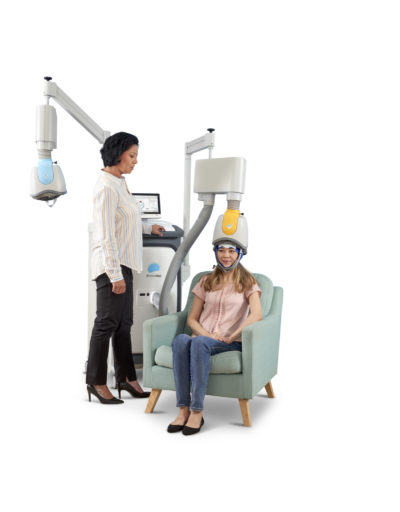TMS Introduction
Summary of TMS and common questions – This article was authored by Dr. Rose George and Liana George.
What is it? TMS is Transcranial Magnetic Stimulation, in other words it is a magnetic field generated by a current running through a magnetic coil that penetrates the skull and stimulates brain cells.
How does it help? In depressive disorders there is a part of the brain that is under active. This causes symptoms of sadness, lack of motivation, low energy, decreased appetite, lack of enjoyment, and feelings of hopelessness. TMS focuses a magnetic field on the area of the brain involved in treatment resistant depression and activates these brain cells to retrain them to be turned on. In anxiety treatment, there is a different area of the brain that is hyperactive and TMS focuses on this area of the brain and a different mode of magnetic stimulation is used to calm these cells.
What does it treat? TMS is FDA approved for treatment resistant Major Depressive Disorder (MDD) and Obsessive Compulsive Disorder (OCD). It is used off label to treat anxiety, bipolar depression, PTSD, addiction, and psychosis.
What does it involve? First the patient is evaluated to see if they meet the qualifications for TMS treatment, which is to be resistant to other depression treatment. In order to be considered treatment resistant a patient would have tried at least two serotonin based antidepressants or SSRIs and at least 2 other types of antidepressant medications – an SNRI or an atypical antipsychotic or other add on treatment for depression. These medication trials must be shown to not be successful in treatment of the depression. The patient must also have had a course of therapy of significant duration also without success.
Once TMS treatments start the patient undergoes 20-30 minutes of TMS 5 times per week for 4-6 weeks and a taper schedule for 3 weeks for a total of 36 treatments. There is no anesthesia, no significant systemic side effects, and the patient can return to work immediately after any session.
Are there individuals who would not qualify for treatment? Anyone with metal plates, pacemakers, or other metal implantable devices near or on the head (except for dental fillings) would not qualify due to heat generated in these metal components by the magnetic field during TMS treatments.
Will insurance cover it? In most instances if the patient meets the criteria set by their insurance company the TMS treatments will be covered by insurance after co-pays and deductibles are met.
What is the success rate? In clinical practice 51% of individuals treated with TMS achieve remission and 75% of individuals treated improve (improvement means at least a 50% reduction in symptoms). This is remarkable considering these individuals have already tried 4 medications and a significant course of therapy.
What is the difference between different brands of TMS machines? TMS machines come in two basic types: figure 8 coil is a generic coil and is used in several types of TMS machines; the other type of TMS has an H coil which refers to a Hebrew word that starts with an H and means compassion and is not in a figure 8 shape. Figure 8 coils penetrate about 1.7 cm into the skull, Brainsway deep TMS with the H coil penetrates 2.7 cm into the skull. The shape of the coil determines the direction of the magnetic field components and thus the strength and duration of the field.

